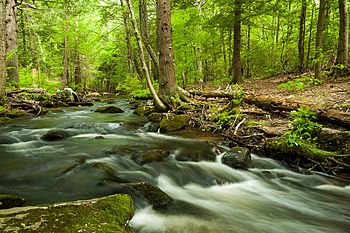Mad River (Connecticut) facts for kids
Quick facts for kids Mad River |
|
|---|---|

Mad River courses through woodlands in Wolcott during late May.
|
|
| Country | United States |
| State | Connecticut |
| Counties | New Haven County |
| Municipalities | Wolcott, Waterbury |
| Physical characteristics | |
| Main source | Outlet of Cedar Lake Wolcott (though Cedar Lake extends north into Bristol) 41°38′10″N 72°58′13″W / 41.63611°N 72.97028°W |
| River mouth | Naugatuck River Waterbury 41°32′30″N 73°02′22″W / 41.54167°N 73.03944°W |
| Length | 11 mi (18 km) |
| Basin features | |
| Basin size | 20.35 sq mi (52.7 km2) |
| Tributaries |
|
The Mad River is a river that flows through northern New Haven County, Connecticut, in the United States. It starts at Cedar Lake near Bristol. The river flows for about 11 miles (18 km) through towns like Wolcott and Waterbury. Finally, it joins the Naugatuck River.
Contents
The Mad River's Early History
Before European settlers arrived, the area around the Mad River was a hunting ground. Native Algonquian people from the Mattabesec and Tunxis tribes lived here. They called this land "Mattatuckoke," which means "place without trees." This area is now known as the Central Naugatuck Valley. People from the Connecticut Colony bought and settled these lands in the 1670s and 1680s.
How the Mad River Helped Industry
Long ago, before big factories, local mills used the Mad River's water. They used it to grind flour, make cider, and cut timber. The river became much more important when brass manufacturing grew in the mid-1800s. Many large factories in Waterbury needed the Mad River to power their heavy machines.
However, the river sometimes didn't have enough water during dry seasons. So, people built dams upstream in Wolcott on the Mad River and its smaller streams. This created reservoirs, which are like large storage ponds. These reservoirs helped make sure there was enough water for the factories all year.
Pollution and Cleanup Efforts
By the late 1800s, the lower parts of the Mad River were very polluted. Factories dumped their waste directly into the river. Also, sewage from many factory workers went into the river. In 1887, someone described the river near a big brass factory as "dark and cloudy." It had a strong smell and oily films on top.
In the 1970s, new environmental rules were made. These rules stopped factories from releasing toxic chemicals into the Mad River and the nearby Naugatuck River. They also made rules about pollution from factory smokestacks. By the 1980s, the brass and copper companies in Waterbury closed their last major factories. This meant much less pollution went into the Mad River.
Enjoying the Mad River Today
The government doesn't have national or state parks along the Mad River. But there are some local parks in Waterbury and Wolcott where people can enjoy the river.
Fun at Scovill Reservoir
Scovill Reservoir is a large lake created by a dam on the Mad River in Wolcott. It covers about 121 acres. This reservoir is a great place for fun activities like fishing, boating, swimming, and hiking. Wolcott's Peterson Park is also located along the Mad River. The 35-mile CFPA Blue-Blazed Mattatuck Trail starts in this park. It follows the Mad River through a beautiful woodland area.
Hamilton Park in Waterbury
Further downstream in Waterbury, you'll find Hamilton Park. This 93-acre park includes a part of the Mad River. Here, you can go swimming, ice skating in winter, and hiking. The park also has sports fields, but these don't directly use the river.
Wildlife in the Mad River
The parts of the Mad River that flow freely usually don't have many game fish. For example, the official Connecticut Angler's Guide didn't even mention the Mad River in its list of fishing spots in 2015. The river's water levels can change a lot with the seasons. Also, there aren't many deep pools. This means coldwater fish, like native brook trout, might struggle when the water gets warm. Dams along the river in Wolcott and Waterbury also block fish from moving freely.
Fish in the Reservoirs
However, the lakes and ponds created by dams on the Mad River are different. These areas are deeper, cooler, and larger. This allows many types of fish to live there. Scovill Reservoir, for instance, is home to trout, largemouth bass, sunfish, yellow perch, chain pickerel, and black crappie. Since 2013, Scovill Reservoir has been a "Catfish Lake." It is regularly stocked with channel catfish.
Scovill Reservoir also has a lot of bowfin. This is a large, ancient-looking fish that is common in the Southern United States. But it's very unusual to find them in New England! Someone illegally put these fish into the reservoir in the 1970s, and they have lived there ever since.


